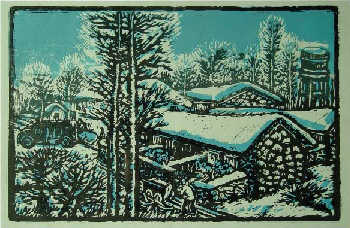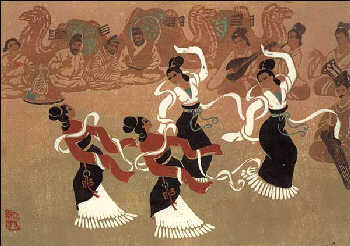 Just like other categories of fine arts, Chinese print, which was mainly engraved on wood blocks in ancient China, enjoys a long history with excellent achievements and artistic importance. In addition to woodblock prints, there were also copperplate prints and colored multi-block prints in ancient China. The Chinese traditional woodblock prints incarnate subjects by cutting andprinting. They can be appreciated from the aspects of gravers, woods, and water.
Just like other categories of fine arts, Chinese print, which was mainly engraved on wood blocks in ancient China, enjoys a long history with excellent achievements and artistic importance. In addition to woodblock prints, there were also copperplate prints and colored multi-block prints in ancient China. The Chinese traditional woodblock prints incarnate subjects by cutting andprinting. They can be appreciated from the aspects of gravers, woods, and water.
Although there have been no agreements as to when the history of Chinese print began, it is generally acknowledged that woodblock prints were already well developed more than a thousand years ago, in theTang Dynasty(618-907).
A surviving scroll of a Buddhist text, the Diamond Sutra, which was found in 1900 in theDunhuangcaves, dates back to the ninth year of the reign of Emperor Xiantong (868) and is probably the earliest extant woodblock printed "book" in the world with an exact date. It is skillfully engraved and finely printed.
By the time of the Song (960-1279) and Yuan (1271-1368) dynasties, woodblock art was thriving. Techniques quickly developed for printing in a number of styles, and both literary and utilitarian books with illustrations were produced in large quantities, soon becoming commodities. A lot of print centers emerged in the Song Dynasty.
But Chinese prints did not stop with woodblocks. Colored multi-block print also saw booming growth. One of its representative works is Figure of Sakyamuni, which is the earliest extant colored multi-block print and boasts great significance in the world's art history.
With the development of the society, copperplate prints appeared in the Song Dynasty and were often employed to printpapercurrency and advertisements. The block-printed edition of Pinghua at that time was the predecessor of the interlink prints in today's China.
Due to the improvement of printing techniques and folk literature, the development of block prints reached its peak in theMing Dynasty(1368-1644). Along with the development of commerce and the handicraft industry and the increasing demand for rich cultural life by the urban people, the thriving dramatic literature became the engine for the growth of block-printed "books" with illustrations. Accordingly, more print centers emerged.
Joining Jian'an in East China'sFujian ProvinceandHangzhouin East China'sZhejiang Province,NanjingandBeijingbegan to witness rapid development in printing. In the second half of the Ming Dynasty, Huizhou in East China'sAnhui Province, from which numerous outstanding engravers spread nationwide, gradually became well known as a trend-setting leader in block printing.
The content of the block-printed "books" in the Ming Dynasty also witnessed an unprecedented enrichment. While maintaining the original themes on Confucianism,Buddhism, and Taoism, these "books" were largely occupied with novels, operas, utilitarian sciences, and paintings. As a result of the collaboration between painters and engravers, the illustrations of these books played an increasingly important role in diffusing knowledge in art, science and technology, and even democratic ideology.
The development of Chinese prints in the Ming Dynasty is usually divided into three stages: the early, middle, and late stages. During the early and middle stages, many "books" were engraved by Guozijian, a department in the royal administration both in Nanjing and Beijing. Meanwhile, some less serious "books" were also engraved with the common people as the target readers. Stories and illustrations, with the Story in the Western House (Xixiangji) in 1498 as a typical example, successfully depicted many multi-faced characters with simple styles.
The late stage of the Ming Dynasty covered the last 120 or so years from 1522 to 1644. A large number of novels and utilitarian "books" were made in Jian'an. In these "books" there were usually text and illustrations on the same page, with text in the upper half and illustrations in the lower one. Furthermore, many engraving houses were established in the Song Dynasty.
 Huizhou-Style Print
Huizhou-Style Print
Enjoying the reputation of being the manufacturing center for paper and Chinese ink, Huizhou boasted many adept painters and engravers. The most famous engravers in Huizhou were the Huang Clan from Yachuan Village.
 Jinling (today's Nanjing)-style Print
Jinling (today's Nanjing)-style Print
Besides Huizhou, Nanjing was another important center for print arts in the Ming Dynasty. Some engraving houses majored in carving illustrations for dramatic novels, and some engraved and printed a lot of valuable art "books."
